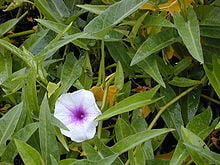Ipomoea aquatica

Ipomoea aquatica is a semi-aquatic, tropical plant grown as a vegetable for its tender shoots and it is not known as to where it originated. This plant is known in English as water spinach, river spinach, water morning glory, water convolvulus, or by the more ambiguous names Chinese spinach, Chinese watercress, Chinese convolvulus or swamp cabbage, or kangkong in Southeast Asia and ong choy in Cantonese.[2][3]
Ipomoea aquatica grows in water or on moist soil. Its stems are 2–3 metres (7–10 ft) or longer, rooting at the nodes, and they are hollow and can float. The leaves vary from typically sagittate (arrow head-shaped) to lanceolate, 5–15 cm (2–6 in) long and 2–8 cm (0.8–3 in) broad. The flowers are trumpet-shaped, 3–5 cm (1–2 in) in diameter, and usually white in colour with a mauve centre. Propagation is either by planting cuttings of the stem shoots, which will root along nodes, or by planting the seeds from flowers that produce seed pods.[4][5]
The origin of I. aquatica is not quite clear, but it is agreed that it is native in Southeast Asia.[6] Within Asia, several sources cite China as the location of the plant’s domestication.[7][8][9][6] On the other hand, India has been suggested as the location of the plant’s origin.[10][11][12] However, none of these sources give references other than when the name of I. aquatica first appeared in historical documents.[13] There are also studies suggesting that the species is native to Africa,[14][15] and it is debated whether it is part of African indigenous flora or whether it was introduced there by Chinese mariner Zheng He.[16]
